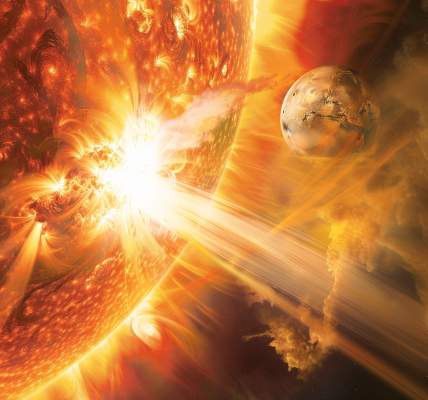The arrangement of our Solar System’s planets has long intrigued scientists and astronomers. Recent research suggests that the orbits of these celestial bodies may have been influenced by a massive planet, potentially larger than Jupiter, that passed through our Solar System in its formative years.
For decades, the concept of planetary migration has been a dominant theory in explaining how the planets have settled into their current orbits. This theory posits that gravitational interactions among the young planets and the surrounding protoplanetary disk caused them to shift their positions, either moving closer to or further away from the Sun.
A new hypothesis, however, posits that an external force may have played a critical role in shaping the orbits of the planets. Researchers propose that a massive object, with a mass between 2 and 50 times that of Jupiter, could have traversed the Solar System, significantly impacting the orbits of the existing planets.
The formation of the Solar System began with a rotating disk of gas and dust surrounding a nascent Sun. As this material coalesced, it formed a plane, resulting in circular orbits that were aligned. However, as the planets grew in size, interactions within the protoplanetary disk initiated a series of migrations, causing planets to shift inwards or outwards. These migrations were further complicated by gravitational interactions that altered the eccentricity and inclination of the orbits, sometimes leading to the ejection of protoplanets from the Solar System.
In addition to these internal dynamics, tidal forces exerted by the Sun also contributed to changes in orbital paths. The early Solar System was a chaotic environment, where protoplanet ejections were relatively common. Interestingly, while these ejections occurred frequently, encounters with celestial objects from outside the Solar System were much rarer, yet they provide valuable insights into the dynamics of planetary systems.
One notable interstellar visitor, ‘Oumuamua’, was discovered in 2017 and marked the first confirmed instance of an object originating from another star system entering our own. This elongated object exhibited unusual acceleration, which scientists believe may have been caused by outgassing or other non-gravitational forces acting upon it.
In light of these observations, a team of scientists led by Garett Brown from the University of Toronto recently published a paper suggesting that such an interstellar object could have been instrumental in altering the orbits of our Solar System’s planets. The researchers focused on the eccentricity of the gas giants and found that existing theories could not adequately explain the observed orbital characteristics.
Instead, they propose that the passage of a massive object—specifically one with a perihelion distance of less than 20 astronomical units and a hyperbolic excess velocity of less than 6 km/s—could account for these anomalies. Their calculations indicate that the gravitational influence of this hypothetical passing planet could have had significant repercussions on the orbits of the gas giants, leading to the current configuration we observe today.
This theory not only provides a potential explanation for the peculiar orbits of the gas giants but also opens up new avenues for understanding the dynamics of our Solar System’s formation and evolution. As researchers continue to explore the implications of this hypothesis, it may shed light on the complex interactions that have shaped not only our Solar System but also others throughout the galaxy.
As we delve deeper into the mysteries of our cosmic neighborhood, the possibility of external influences reshaping planetary systems remains a tantalizing area of study. The ongoing research into the dynamics of planetary orbits will undoubtedly enhance our understanding of the intricate dance of celestial bodies in the vastness of space.





